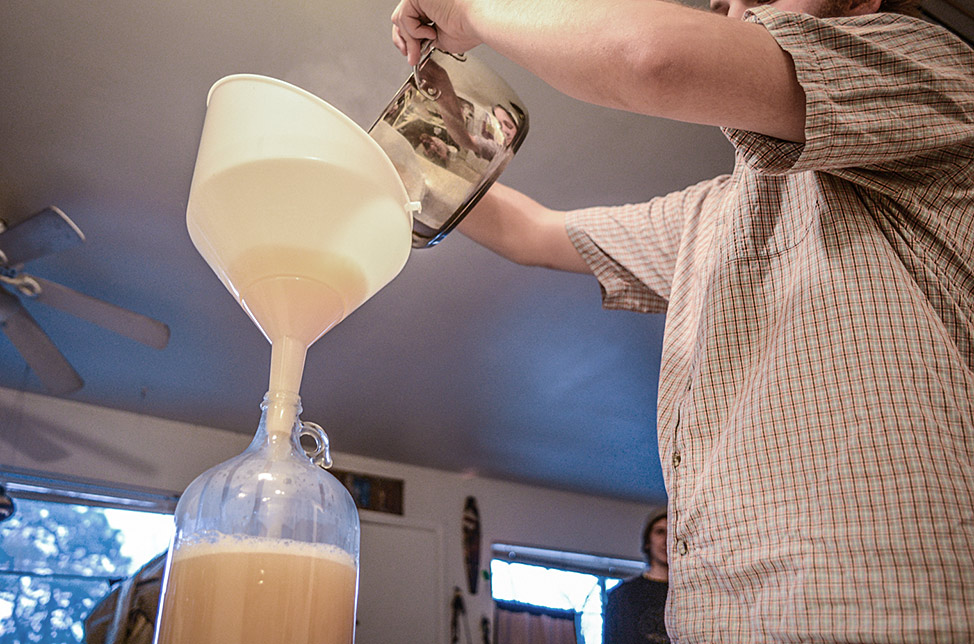4 Benefits of the Small Batch Brew
1. It’s cheap. Whether or not you have any brewing supplies, the cost of equipment is reasonable and the ingredients for 1-gallon batches start around $10-$15, depending on the style. Also, less energy is needed to heat, boil and chill wort compared to larger volumes.
2. Small footprint. With smaller equipment, most everything can be stored on a closet shelf or under a bed when not in use. During the brew day, the entire process can be conducted in a 2 to 4-gallon pot, freeing up the rest of your stove and kitchen to make dinner, or better yet, another homebrew. Fermenters are roughly the size of a 1-gallon water jug, and will fit nicely on a shelf or tabletop.
3. It’s fast. It takes minimal time to bring 2 to 3-gallons of liquid to strike temperature and boil. Chilling is also significantly faster, and can be sped up by using your freezer. The smaller scale of the entire process also creates a much more manageable mess to clean.
4. Low risk. Whether you’re a newbie testing the waters of homebrewing, or a seasoned veteran looking to get experimental, the low cost of ingredients will allow you to brew adventurously. After all, if your franken-brew comes out questionable, you only have about ten 12-ounce bottles to choke down instead of a few cases.

Gearing Up
You probably already have a 2 to 4-gallon pot, funnel and maybe even a kitchen thermometer. That leaves a 1-gallon glass jug, airlock, bung and (mini) siphon. Throw in a 2-gallon primary bucket, grain bag and hydrometer, and you’ve got yourself a pico-homebrewery.
Bottling equipment is more or less the same as usual, but a 2-gallon plastic bucket can be rigged with a spigot for small batch bottling.
Mini-Recipes
Ingredients for a 1-gallon recipe can start around $10-$15 for simpler styles, with yeast comprising most of the cost. As the recipes include more ingredients, the price will increase, but rarely over $25-$30 for most styles.
It is up to the brewer to put together a 1-gallon recipe, as they are not widely available in recipe books or as kits. The ingredients in a favorite 5-gallon recipe can be divided by five for a rough approximation, or brewing software can be used for more precise scaling.
If developing your own recipe from scratch, conceptualize the grains as percentages. Percentages are easier to deal with when using such small amounts of individual ingredients, and scaling up a recipe to any size is a breeze.

Small Batch Brewing
Extract and partial mash brewers can go about business as usual, taking extra care not to let the extract scorch on the bottom of the pot. All-grain brewers have some options.
For the sake of simplicity (and cheapness), mash small batches using the brew in a bag technique. (www.brew-boss.com) The entire brew day process can be conducted in one 3 or 4-gallon pot—simply mash the grains in a large grain bag, remove the bag once complete and carry on with the boil. If small batch brewing is your calling, consider building a mini mash tun and sparging for higher efficiency.
The small volume of wort requires much less yeast than you may be used to. In fact, if you pitch an entire yeast pack into some 1-gallon recipes, you may actually be over-pitching, an issue not common to the typical homebrewer. It is worth the few dollars to purchase a small measuring cup that measures by the half ounce for liquid yeast. Use a kitchen scale for dry yeast.
When managing fermentation, you have some options as a pico-homebrewer. A mini-fridge could hold a carboy or two, or a small version of a son of a fermentation chamber can be fashioned to hold multiple fermenters. One of the cheapest and most effective ways is to submerge a 1-gallon carboy into a bucket of water with a cheap, small-volume aquarium heater. The aquarium heaters are temperature controlled, and a frozen water bottle can be used when warmth is an issue.
Extract and partial mash brewers can go about business as usual, taking extra care not to let the extract scorch on the bottom of the pot. All-grain brewers have some options.
For the sake of simplicity (and cheapness), mash small batches using the brew in a bag technique. (www.brew-boss.com) The entire brew day process can be conducted in one 3 or 4-gallon pot—simply mash the grains in a large grain bag, remove the bag once complete and carry on with the boil. If small batch brewing is your calling, consider building a mini mash tun and sparging for higher efficiency.
The small volume of wort requires much less yeast than you may be used to. In fact, if you pitch an entire yeast pack into some 1-gallon recipes, you may actually be over-pitching, an issue not common to the typical homebrewer. It is worth the few dollars to purchase a small measuring cup that measures by the half ounce for liquid yeast. Use a kitchen scale for dry yeast.
When managing fermentation, you have some options as a pico-homebrewer. A mini-fridge could hold a carboy or two, or a small version of a son of a fermentation chamber can be fashioned to hold multiple fermenters. One of the cheapest and most effective ways is to submerge a 1-gallon carboy into a bucket of water with a cheap, small-volume aquarium heater. The aquarium heaters are temperature controlled, and a frozen water bottle can be used when warmth is an issue.
Share the Love
So what are you waiting for? Grab yourself a 1-gallon jug and start small batch brewing! Not only is this a great opportunity for all homebrewers to get experimental, it is an affordable gift to get your non-homebrew friends hooked on the obsession that is beer making.
https://www.homebrewersassociation.org/how-to-brew/a-big-idea-on-small-batch-brewing/
No comments:
Post a Comment